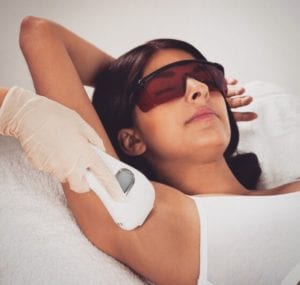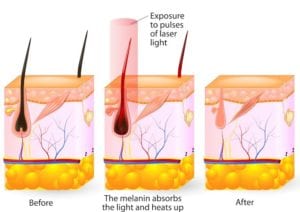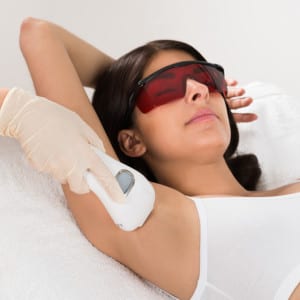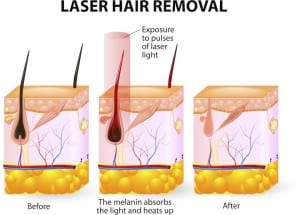
Many of us are fed up with continually shaving and waxing to get rid of unwanted hair. IPL is a method of semi-permanent hair removal which is becoming more and more popular. Shaving and waxing simply remove hair from the surface of the skin whereas IPL treatments use focused light energy to destroy the hair at the follicles. In this blog article we answer questions commonly asked by clients prior to having IPL hair reduction treatments.
How many IPL treatments will I need?
It is important to note that complete hair removal is very unlikely in a single treatment. Typically most clients require around six treatments however this is dependent on the colour of your hair, thickness of your hair and colour of your skin. IPL targets hair in the active growth phase and you should expect hair reduction of around 10 – 25 percent per treatment. IPL works by transmitting energy across the skin and the energy is absorbed by the pigments in the hair shaft and transmitted down to the follicle. What this means is that the IPL targets the pigment. We find that IPL is most effective on clients with dark hair and light skin. This is one of the reasons why we recommend having IPL treatments in the winter months when hair is less likely to be bleached by the sun and skin is less likely to be tanned.
 How long do results of IPL last?
How long do results of IPL last?
Now many companies often describe IPL as a method of permanent hair removal leaving clients disappointed when around a year after the initial course of treatments their hair begins to grow back. We refer to IPL as a semi-permanent hair removal treatment as although the initial course of treatments will remove all of your hair follicles your body will eventually produce and develop more. We find that clients typically require a ‘top-up’ treatment once every six to twelve months to keep unwanted hair away!
Am I suitable for IPL?
Although IPL is most effective on those with light skin and dark hair pretty much anyone can have IPL hair removal. As IPL targets the pigment completely white hair can be difficult to treat. Typically we find that the lighter the hair colour the more treatment sessions are required. When considering the skin, we want the energy to be absorbed by the pigment in the hair follicles, not the pigment in the skin, so we have to change the energy levels in darker skin types, so dark skin types may also require more sessions to get a good result. So all in all anyone can have the IPL hair reduction but you may require additional treatments.
How should I prepare for treatment?
Limit your sun exposure.
In fact if you have had sun exposure within 72 hours of your treatment you cannot receive the treatment! Most of us with ‘Scottish skin’ tend to burn in the sun. But all of our skin, even those lucky ones who tan well, can become much more sensitive to heat (from sun exposure) without us even knowing it! If you were out in the sun 72 hours before your IPL treatment you would run the risk of scarring, burning or seriously damaging your skin. It is because of this we would not be able to perform your IPL treatment if you had sun exposure in the last 72 hours.
Limit your use of self-tanners
As IPL targets dark pigment we also ask that you limit your use of self-tanners prior to your IPL treatments. Fake-tan can cause the IPL to target the ‘fake’ pigment on your skin rather than the hair follicle. Not only will this make the treatment less effective but it could potentially damage your skin. If you use fake-tan prior to your treatment we will not be able to perform the IPL treatment.
Refrain from plucking, waxing or bleaching the area.
Before your IPL hair reduction treatment we ask that you refrain from plucking or waxing the area to be treated for at least 2 – 4 weeks. We also ask that you do not bleach the hair. Plucking, waxing and bleaching reduces the effectiveness of the treatment. If you do pluck, wax or bleach the IPL treatment will not be as effective and you will require additional treatments.
Shave the treatment area.
If you do want to get rid of unwanted hair in between treatments, shaving is absolutely fine. In fact we ask that you shave the area to be treated a day or two prior to your treatment. When IPL hair reduction is performed the hair follicles should be visible however if longer hair is visible it could be slightly more painful. At Clinetix our aestheticians are expertly trained so if they find that the hair is too long they will shave the area.
What should I expect from the treatment?
Before your treatment begins we will clean the treatment area to ensure there are no lotions, cosmetics or deodorants left on the skin. You will be given a pair of protective eye wear and we will apply a cool gel to the area to be treated. The treatment involves a number of applications called ‘pulses’ to be applied to the area. It is not a painful treatment and many clients describe the sensation as a ‘pinch’ or a ‘flick’.
What kind of aftercare does IPL require?
After your IPL treatment there is no downtime and you can continue your normal activities after treatment. However as your skin is likely to be sensitive we recommend using an SPF on sun exposed areas. Excessive skin exposure after treatment risks damaging your skin so we advise that you avoid sunbathing or tanning beds.
After your treatment the targeted hair will look like it’s growing again. This is when the hair begins to make its way out of the follicle. Around two weeks after your IPL treatment your hair will shed and fall out. At this time you will be able to gently remove it with a washcloth in the bath or shower. When your hair is shedding, let it fall out naturally. Please do not pluck or wax the treatment area! If the hair has not fallen out naturally it means that the root is still alive and that the hair will need to be targeted again in another treatment. You can shave after your IPL treatments but avoid any treatments that pulls hair out by the roots.
If you have any other questions that we have not covered please contact us on info@clinetix.co.uk. To book a chat and a patch test call one of our clinics on or 0141 221 0229 (West End) or 01698 854 221 (Bothwell).



